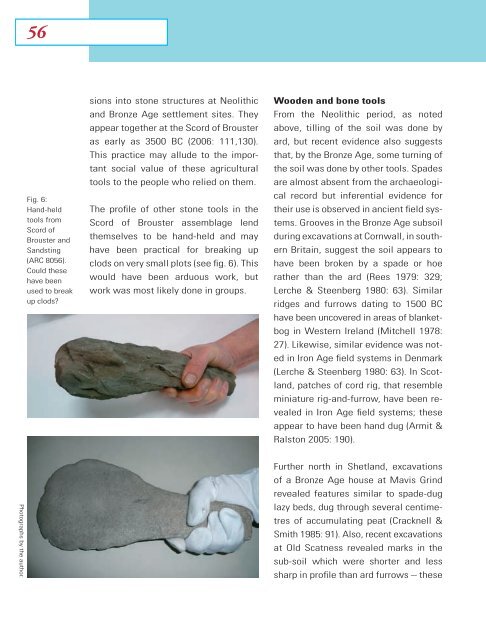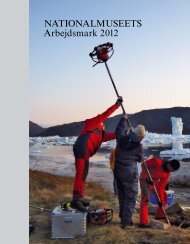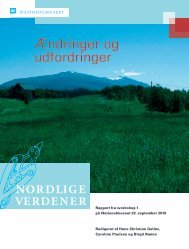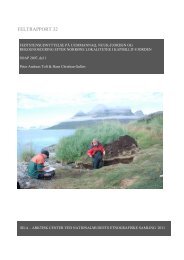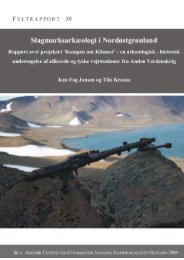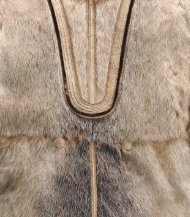The Border of Farming and the Cultural Markers - Nordlige Verdener
The Border of Farming and the Cultural Markers - Nordlige Verdener
The Border of Farming and the Cultural Markers - Nordlige Verdener
You also want an ePaper? Increase the reach of your titles
YUMPU automatically turns print PDFs into web optimized ePapers that Google loves.
56<br />
Fig. 6:<br />
H<strong>and</strong>-held<br />
tools from<br />
Scord <strong>of</strong><br />
Brouster <strong>and</strong><br />
S<strong>and</strong>sting<br />
(ARC 8056).<br />
Could <strong>the</strong>se<br />
have been<br />
used to break<br />
up clods<br />
sions into stone structures at Neolithic<br />
<strong>and</strong> Bronze Age settlement sites. <strong>The</strong>y<br />
appear toge<strong>the</strong>r at <strong>the</strong> Scord <strong>of</strong> Brouster<br />
as early as 3500 BC (2006: 111,130).<br />
This practice may allude to <strong>the</strong> important<br />
social value <strong>of</strong> <strong>the</strong>se agricultural<br />
tools to <strong>the</strong> people who relied on <strong>the</strong>m.<br />
<strong>The</strong> pr<strong>of</strong>ile <strong>of</strong> o<strong>the</strong>r stone tools in <strong>the</strong><br />
Scord <strong>of</strong> Brouster assemblage lend<br />
<strong>the</strong>mselves to be h<strong>and</strong>-held <strong>and</strong> may<br />
have been practical for breaking up<br />
clods on very small plots (see fig. 6). This<br />
would have been arduous work, but<br />
work was most likely done in groups.<br />
Wooden <strong>and</strong> bone tools<br />
From <strong>the</strong> Neolithic period, as noted<br />
above, tilling <strong>of</strong> <strong>the</strong> soil was done by<br />
ard, but recent evidence also suggests<br />
that, by <strong>the</strong> Bronze Age, some turning <strong>of</strong><br />
<strong>the</strong> soil was done by o<strong>the</strong>r tools. Spades<br />
are almost absent from <strong>the</strong> archaeological<br />
record but inferential evidence for<br />
<strong>the</strong>ir use is observed in ancient field systems.<br />
Grooves in <strong>the</strong> Bronze Age subsoil<br />
during excavations at Cornwall, in sou<strong>the</strong>rn<br />
Britain, suggest <strong>the</strong> soil appears to<br />
have been broken by a spade or hoe<br />
ra<strong>the</strong>r than <strong>the</strong> ard (Rees 1979: 329;<br />
Lerche & Steenberg 1980: 63). Similar<br />
ridges <strong>and</strong> furrows dating to 1500 BC<br />
have been uncovered in areas <strong>of</strong> blanketbog<br />
in Western Irel<strong>and</strong> (Mitchell 1978:<br />
27). Likewise, similar evidence was noted<br />
in Iron Age field systems in Denmark<br />
(Lerche & Steenberg 1980: 63). In Scotl<strong>and</strong>,<br />
patches <strong>of</strong> cord rig, that resemble<br />
miniature rig-<strong>and</strong>-furrow, have been revealed<br />
in Iron Age field systems; <strong>the</strong>se<br />
appear to have been h<strong>and</strong> dug (Armit &<br />
Ralston 2005: 190).<br />
Photographs by <strong>the</strong> author.<br />
Fur<strong>the</strong>r north in Shetl<strong>and</strong>, excavations<br />
<strong>of</strong> a Bronze Age house at Mavis Grind<br />
revealed features similar to spade-dug<br />
lazy beds, dug through several centimetres<br />
<strong>of</strong> accumulating peat (Cracknell &<br />
Smith 1985: 91). Also, recent excavations<br />
at Old Scatness revealed marks in <strong>the</strong><br />
sub-soil which were shorter <strong>and</strong> less<br />
sharp in pr<strong>of</strong>ile than ard furrows – <strong>the</strong>se


